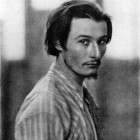1891 – 1915::Henri Gaudier was born in Saint-Jean-de-Braye near Orléans. In 1910, he moved to London to become an artist, even though he had no formal training. With him came Sophie Brzeska, a Polish writer over twice his age whom he had met at the Bibliothèque Sainte-Geneviève in Paris, and with whom he began an intense relationship, annexing her surname although they never married. (According to Jim Ede the linking of their names was never more than a personal arrangement.) During this time his conflicting attitudes towards art are exemplified in what he wrote to Dr. Uhlmayr, with whom he had lived the previous year.He resolved these reservations by taking up sculpture, having been inspired by his carpenter father. Once in England Gaudier-Brzeska fell in with the Vorticism movement of Ezra Pound and Wyndham Lewis, becoming a founding member of the London Group. After coming under the influence of Jacob Epstein in 1912, he began to believe that sculpture should leave behind the highly finished, polished style of ancient Greece and embrace a more earthy direct carving, in which the tool marks are left visible on the final work as a fingerprint of the artist. Abandoning his early fascination for Auguste Rodin, he began to study instead extra-European artworks located in the British Museum and the Victoria and Albert Museum. As he was unable to afford the raw materials necessary to attempt projects on the scale of Epstein’s Indian and Assyrian influenced pieces, he concentrated initially on miniaturist sculpture genres such as Japanese netsuke before developing an interest in work from West Africa and the Pacific Islands.In 1913, he assisted with the illustrations of Haldane Macfall’s book The Splendid Wayfaring along with Claud Lovat Fraser and Edward Gordon Craig. In 1913 Henri Gaudier-Brzeska met Alfred Wolmark, the Jewish artist and modelled a bronze bust of the young artist, and the two remained close friends.Gaudier-Brzeska’s drawing style was influenced by the Chinese calligraphy and poetry which he discovered at the “Ezuversity”, Ezra Pound’s unofficial locus of teaching. Pound’s interaction with Ernest Fenollosa’s work on the Chinese brought the young sculptor to the galleries of Eastern art, where he studied the ideogram and applied it to his art. Gaudier-Brzeska had the ability to imply, with a few deft strokes, the being of a subject. His drawings also show the influence of Cubism.At the start of the First World War, Gaudier-Brzeska enlisted with the French army. He appears to have fought with little regard for his own safety, receiving a decoration for bravery before being killed in the trenches at Neuville-St.-Vaast. During his time in the army, he sculpted a figure out of the butt of a rifle taken from a German soldier, “to express a gentler order of feeling”

